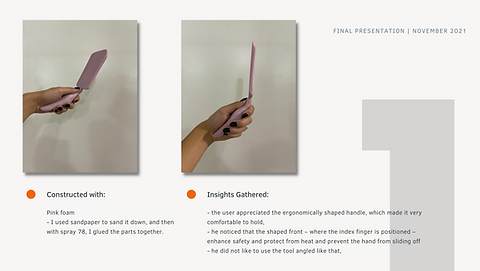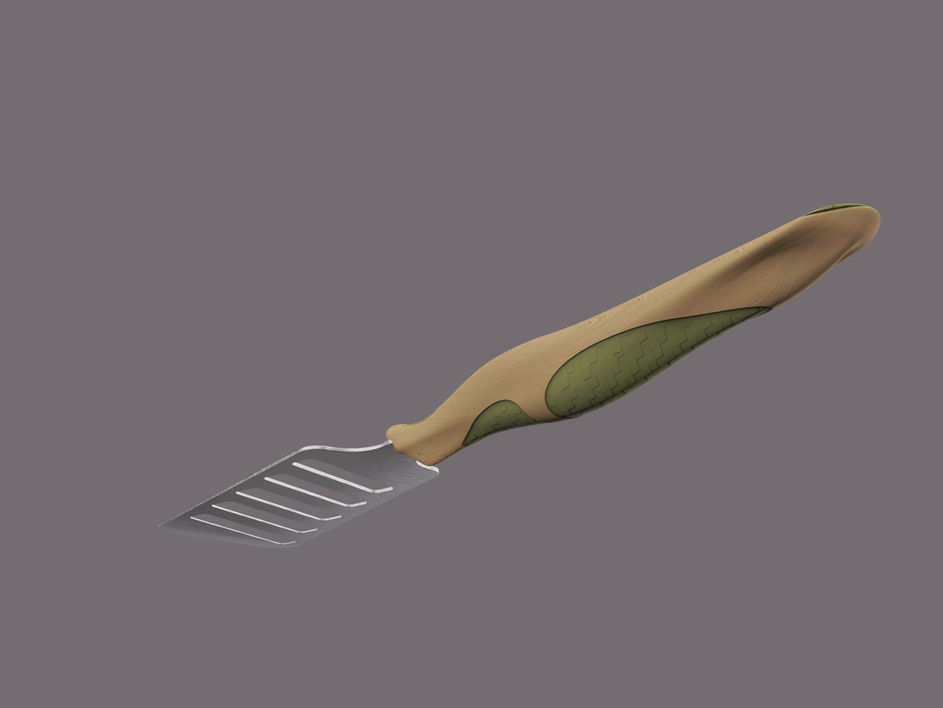

Spatula 'turner'
kitchen utensil
Human Factors Study Breakdown
Create a hand tool designed with human factors at the forefront. Consider pain points, ergonomics, and designing for the user so that the user does not need to adapt to the product.
I decided to explore the use of turner - a kitchen tool also called 'spatula'. I wanted to evaluate the usage of this tool and see how this handheld device could be improved.
Projects Components
Final Concept
Prototyping
Observation and Research
Research - The best spatulas and key factors
• “It is a very challenging thing to flip a fish without breaking. As a chef at a restaurant, I quickly figured that if your spatula can flip fish most other tasks would be a piece of cake, so I headed into the test kitchen to make a wide variety of foods. The fish spatulas are a favorite tool to use when flipping foods and not just for fish they have heads that are extra long tapered and slotted designed to slip under almost any kind of food.“
• "That extra space makes a difference with short heads, fragile foods like pancakes and soft cookies sometimes hit the back end near the handle and got dented if we slid that spatula under them a little too vigorously heavier foods like burgers sometimes fell backward right back onto the cooking surface and long fish fillets and large pancakes draped over the sides and threatened to break or fall off."
• "Fish spatulas are moderately flexible. They hugged the cooking surface and slipped quickly underneath all the foods without tearing or bumping. However, they were still substantial enough to support heavier foods and do a little scraping the shape of the fish spatulas' heads was slim and tapered out from the base and this made them feel much nimbler so they could get into the tightest spaces."
• "Their extra length gives food a bigger landing strip - it has plenty of support for bigger foods."
• "Handles were four and a half to five inches long, which moved our hands closer to the action, so we had more control for flipping and scooping."
Interview answers - restaurant chefs
Process Map

Competative anaysis

Diagrams



The uncomfortable inclination
With the steady and angled handle of the turner, the cook's hand has a very uncomfortable angle when operating the tool. The whole body was involved when making maneuvers.
Unreliable design
Pain Points
The user's grip and inclination must be modified from the typical way of holding this tool throughout this operation. It is not steady, making it unreliable for operation and inconvenient for the user.
Safety
The users' hand is dangerously close to the pan. The reason for that is the angle that the cook is using to operate and the unreliable grip that she uses for the maneuver.
Lack of balance between steadiness and flexibility
The turner on the left is excessively steady and broad, making it difficult for the operator to slide the tool beneath the omelet and causing it to break.
Prototyping
After performing an observation and analyzing the task and its pain points, I moved to the prototyping phase where I have built 3 prototypes to test them with the user and extract insights.


Concept sketches


After analyzing each prototype and getting feedback from the users I chose the most successful one and sketched out some form exploration.
Final Concept
Form exploration helped me in coming up with the final design.

Prototype User-testing








